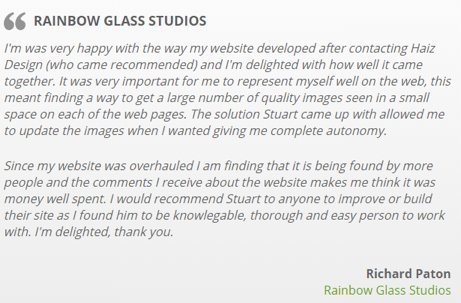You’ve been thinking about asking your past or active client(s) for a testimonial. You ponder about the best way to do that, but you still haven’t taken action.
You want to get it right, but;.
- You don’t want to sound demanding.
- You don’t want to sound unprofessional.
- You’re worried about rejections.
- You don’t know how to ask for it correctly.
- You’re afraid that it’s written poorly.
Since you cannot control the testimonial, you’re probably not sure if the feedback they provide will be good enough to profile it as a riveting testimonial. I get it.
I’ve been in the same spot as you are before. Been in this graphic design business for close to 20 years now, and I’ve collected over a dozen astonishing reviews.
You can see some of them on my LinkedIn profile.

And, others are profiled on my website.
I wasn’t always proactive in this marketing approach, and I’ve made a few mistakes along the way. This costs time and money you want to save.
You see, I thought satisfied clients would automatically share with me their after-service thoughts, and I’d get their testimonials without me asking for it.
I was utterly wrong about everything Clients don’t offer to write a testimonial, let alone write ones that work for you.
This is why I’ll show you what makes a great testimonial, why some lack substance, and how they profiled wrong.
There’s a 3-step formula I want you to use IF you’re ready to generate fantastic client feedback and customer testimonials:
Step #1: Serve your clients beyond expectations
To get clients raving about your service, you need to make them feel that what you gave them was beyond what they expected from you and would not have received it anywhere else. Make them a fan of your work.
Use this 2-step process to impress them.
- Incorporate a consulting/consultative approach to understand the pain points and their biggest challenges fully. Couple this with your first-rate graphic design service delivery.
- You won’t receive a solid testimonial until you’ve served the client with your service, and you’ve helped them achieve the goals they wanted in the first place.
Because people value the opinions of others; Every business needs raving client testimonials. But, often have these problems:
(1) Most don’t get them because they either don’t surprise the client or don’t ask for them.
(2) If they get them, they’re not created the way that would benefit the business.
(3) Or the way it’s displayed (how the business decides to showcase it) sucks.
That’s where YOU come in!
Make your marketing abilities and graphic design skills the platform to enhance your clients’ business and personal brand. This unlocks the door to receiving raving testimonials a standard in your business.
Step #2: Strike while the iron is hot.
When the client is at their happiest with your results; ask them for a story highlighting how your partnership helped them achieve X results. And more importantly, how your abilities helped them fix a major problem or need in their life and business.
This means addressing a few specific points regarding your work. Choose which aspects you’d like to highlight and ask your client to focus on those only. This shows prospects that you’re able to help them with probably the same challenges too.
E.g., You and your client might decide on highlighting what the biggest challenge was before working with you. Then discuss how you removed surface pain points and the core basis of the challenge.
Most testimonials in the industry are great at focusing on how amazing the service provider is and the excellent results the client received. But doesn’t emphasize the core problem solved.
Example. Let’s take a look at this testimonial and dissect the issues that it’s missing.

On the surface, this testimonial seems fine. However, there are a few things that could’ve been done differently.
First, a major mistake is that the testimonial features the company name instead of the problem faced by their client and the result they’ve achieved.
Secondly, all text is featured in italics, and there’s no eye-catching element to stand out, such as bolding.
Third, there’s no headshot of the client, thus not emphasizing the legitimacy of the testimonial. In today’s world, most testimonials can be faked. Having legitimate testimonials is vital as a genuine social proof element.
That’s why you’ll have to do whatever it takes to showcase their personal data (with their consent) such as company/name, headshot, website URL, and social media links.
The best social proof format is a video testimonial. I highly recommend you get a few of those in particular and display them on your website and digital marketing campaigns too.
Step #3: Engage clients on LinkedIn, get recommendations
Don’t underestimate the power of using LinkedIn to show you as an authority in the graphic design industry. Displaying your testimonials under your profile lets customers decide whether you’re the one that they’d want to work with.
This platform is ideal for profiling real, non-edited customer testimonials, and client feedback. Still, it lacks the bolding features of a testimonial which you can profile on your website or on social media channel, where you have control over the content/text and its display.
LinkedIn also allows other professionals to recommend the skills that you have. Ask your clients to use this function on your LinkedIn profile.
Don’t be afraid to expand beyond Linkedin. Thinking with a “scarcity” point of view is not a smart thing to do when thinking about generating more business.
There’s no shortage of clients. Linkedin is not the only LIVE and PUBLIC social proof platform you can tap into. There’s also Facebook, Twitter, Instagram, YouTube, Pinterest. The list is continuously increasing. So, it’s best that you find the right platform for you.
Depending on where your dream clients are, you’ll want to fish in those ponds and actively get them to talk about how you and your service helped them overcome their challenges. Testimonials play a vital role in your branding kit. Why? Because people value the opinions of others and want to know what they’re getting themselves into. Focusing on how you solved your client’s specific challenges is critical, as this convinces prospects that you can help them too.


